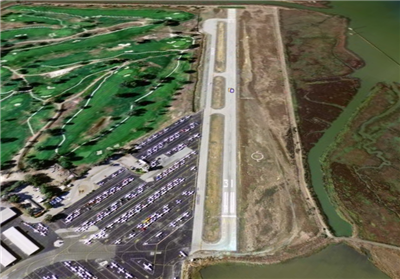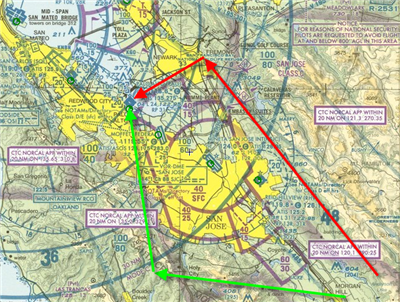As the founder of a software company and a huge tech enthusiast, I’m always intrigued by the number of startups in the Silicon Valley area. Every time I visit the area, I’m jealous of the environment and advantages that companies starting in Silicon Valley have over companies anywhere else in the world. I decided to spend a week in Palo Alto, the heart of Silicon Valley, to hang out and see what it’s like.
Being eager to try out my new Cirrus on a long-distance trip, I decided this would be a great solo trip to test out both the plane and my new piloting skills. Planning for the trip, I realized Palo Alto’s airport has the smallest runway I’ve ever seen at 2400 feet. Of course, with the SR22’s landing ground roll of about 1200′, that leaves plenty of space for an experienced pilot, but I’m not an experienced pilot, so the runway length was a definite concern.

I decided to practice short approaches at my home airport, Scottsdale (KSDL), noting the amount of runway space I use. Since Scottsdale’s airport has an 8,200′ runway, I had never noticed how much of the runway I eat up on my landings. The first time I took note, I realized I had used 3,000′. Wholly smokes! That would put me right into the bay at Palo Alto. I definitely needed another try. But as soon as I got serious about landing in a short distance, it seemed easy to get out at less than 2,000′, so I felt I was ready for my trip.
I had my fantastic CSIP instructor (he’s reading this, so I have to be complimentary ;-) review my flight plan. Once he gave the thumbs up, I felt good to go.
The 3-hour 15-minute trip itself was extremely smooth. I obtained flight-following from ATC and listened to XM radio to pass the time. One thing I realized is that for long trips, you definitely need sun-screen! The sun can easily burn your skin and there’s not much you can do to avoid it. I ended up using my Cirrus shades on the side window to avoid burning (I know, I know, that’s not a good idea when you’re flying VFR, but having traffic watch and flight-follow and peaking every now and then for traffic, I felt it was a safe decision).
The Approach into KPAO!
The airpsace around KPAO is a huge mess. It’s surrounded by Class D, C and B airspace that makes it quite tricky to get in there. But having done my homework, I was pretty confident that my route of going East of San Jose (Class C) and turning left into Palo Alto would be ideal (see the red lines in the image below).

Unfortunately as soon as I had descended to 4,500′ near San Jose, ATC informed me that I needed to go West of San Jose, not East and that I should make an immediate turn to the West (see the green lines in the above image). That through a big monkey wrench into my plans, especially since the terrain West of San Jose is quite mountainous. I decided to climb to 5,500′ to avoid the terrain and slowed down to about 100 knots. I then obtained clearance through Moffett Federal’s airspace, but the clearance was given at or below 1,500′. Here I was at 5,000′ less than 3 miles from Moffett’s airspace and I needed to descend fast. So I put on full flaps and slowed to 80 knots! I dropped like a tank (thankfully!) and reached the desired altitude of 1,000′ as I finally spotted Palo Alto’s tiny runway.
I was cleared straight into Runway 31, so I enjoyed the scenery as I passed over Stanford’s campus and set myself up. The approach couldn’t have been better. I landed right on the numbers proud that I could easily make the 2nd turn off of the runway when all of a sudden my engine quit. I had previously put the engine into idle as I had landed but in my haste of avoiding airspaces and the change of plans by the ATC, I had forgotten to turn on my fuel boost. Turning on the fuel boost is part of the pre-landing descend checklist. Why that would cause the engine to quit, I have no idea. It seems that there should be more room for error, but I informed the tower that I’ll need more time on the runway as I have to restart my engine. They were cool with it and fortunately, the engine started right up on the first try. Lesson learned!
The trip was very enjoyable and a big confidence builder as it was the first time I had taken a long 3-hour solo trip, about 550 nautical miles. One pleasant surprise was that my entire trip used only 57 Gallons of fuel, leaving me with 35 gallons (or about 2 hours worth) still on-board. Not bad at all!
